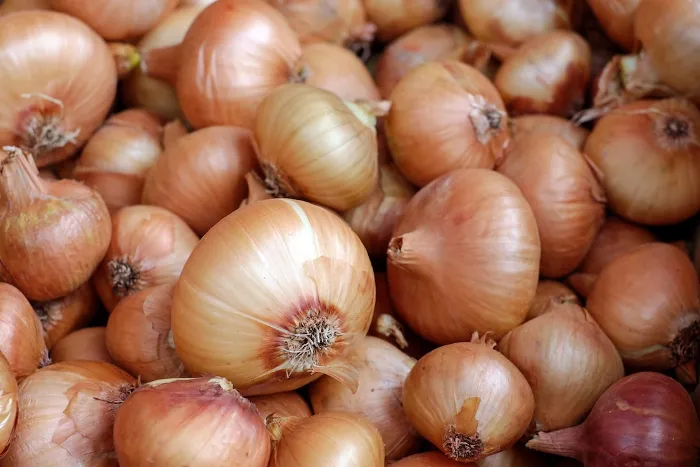When To Pick, Harvest, Cure and Store Onions?

Disclosure: Some of the links in this article may be affiliate links, which can provide compensation to me at no cost to you if you decide to purchase. As an Amazon affiliate I may earn on qualifying purchases
Introduction:
If you're a beginner gardener, growing onions can be a rewarding experience, but knowing when and how to harvest them, as well as how to store them, might seem a bit daunting. Fear not! In this beginner-friendly guide, we'll take you through the essential steps for picking your onions at the right time, curing them properly, and storing them for extended freshness. We'll also highlight some onion varieties that store longer, so you can enjoy the fruits of your labor for months to come!
1. When to Harvest Onions:
For beginners, the right time to harvest onions might seem uncertain, but don't worry—it's not as complicated as it seems. Keep an eye out for these cues to determine the best time to pick your onions:
- Bulb Size: When your onion bulbs have reached a size that seems suitable for eating, they are probably ready to be harvested. Don't worry if they're not as large as the ones you see in stores; small to medium-sized onions can still be delicious!
- Yellowing of Foliage: Once the green foliage above the ground starts turning yellow and flopping over, it's a sign that your onions have matured and are ready for harvest.
- Patience Pays Off: Don't rush! If your onions aren't quite ready based on the above signs, give them a bit more time. Prematurely harvested onions won't store as well.
2. How to Cure Onions:
Curing onions is a crucial step in maximizing their flavor and longevity. Follow these simple steps to cure your onions like a pro:
- Keep the foliage on when drying the onions out
onions just after picked
- Air-Dry in a Warm Spot: Find a warm, dry spot with good air circulation, like a covered porch or a dry garage. Spread the onions in a single layer to ensure even drying. Provide good ventilation or a fan.
- Be Patient: Curing usually takes 1 to 2 weeks. During this time, the outer skin will become papery, and the onions will develop their signature flavor.
onions after 1-2 weeks of curing
3. Proper Onion Storage:
Choosing the right storage method and long-lasting onion varieties will help you enjoy your harvest for months. Here are some storage tips and examples of onions that store well:
-Clip the Foliage: After the foliage has fully dried, snip off the foliage, leaving about an inch of stem attached to the bulb. Onions with bruises or blemished should be eaten first or ones that had flower stalks as these retain moisture even after curing.
- Mesh Bags or Crates: Store your cured onions in mesh bags or ventilated crates to ensure proper airflow, preventing mold or rot.
- Cool, Dark, and Dry: Store onions in a cool (32-45 degrees F at 65-70% humidity), dark, and dry place, such as a pantry or a cellar, to keep them fresh and flavorful.
Here are some onion varieties known for their longer shelf life and better storage capabilities:
1. **Yellow Onions:**
- **'Copra'** - This is a popular yellow onion variety that is well-known for its excellent storage potential. It has a high dry matter content, which contributes to its long shelf life and ability to resist rotting.
- **'Stuttgarter Riesen'** - Another yellow onion variety with good storage qualities. It is known for its large size and long storage duration.
2. **Red Onions:**
- **'Redwing'** - A red onion cultivar that not only has a sweet and mild flavor but also stores exceptionally well. It can remain in good condition for an extended period.
- **'Red Zeppelin'** - This red onion variety is known for its good storage capabilities, making it a favorite among gardeners.
3. **White Onions:**
- **'Ailsa Craig'** - A popular white onion variety that stores well. It is known for its mild flavor and ability to keep for an extended time.
Conclusion:
As a beginner gardener, harvesting, curing, and storing onions can be a fun and rewarding part of your gardening journey. By paying attention to the signs of readiness, following simple curing steps, and choosing long-lasting onion varieties, you can enjoy your homegrown onions for an extended period. With a little patience and care, you'll soon be savoring the delicious taste of your freshly harvested onions in various culinary delights!
Happy gardening and harvesting!
RELATED ARTICLES:
Garden Tiller Review:
https://inthegardensue.com/blog/garden-tiller-reviews-and-buying-guide-an-honest-womans-perspective
Review of the 5 Best Garden Stools for Seniors
https://inthegardensue.com/blog/review-of-the--5-best-garden-stools-for-seniors
How to Sharpen and Maintain Hand Pruners:
https://inthegardensue.com/blog/how-to-sharpen-and-maintain-felco-hand-pruners
The Best Hand Pruners for Arthritic Hands: A Review
https://inthegardensue.com/blog/the-best-hand-pruners-for-arthritic-hands-a-review
Flower Power: Enhance your well being with Indoor Blooms
https://inthegardensue.com/blog/flower-power-enhance-your-well-being-with-indoor-blooms
Disclosure: Some of the links in this article may be affiliate links, which can provide compensation to me at no cost to you if you decide to purchase. As an Amazon affiliate I may earn on qualifying purchases



